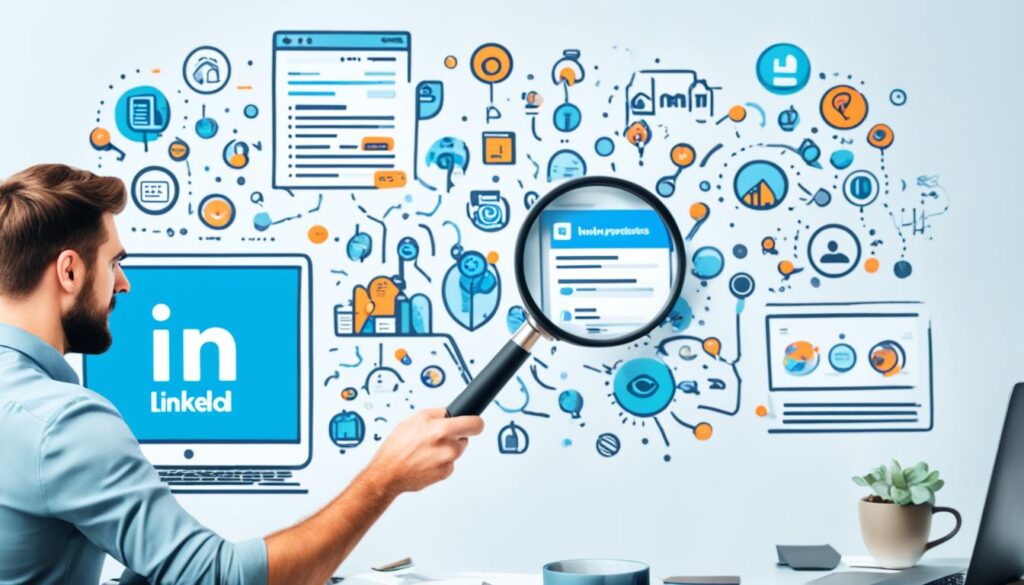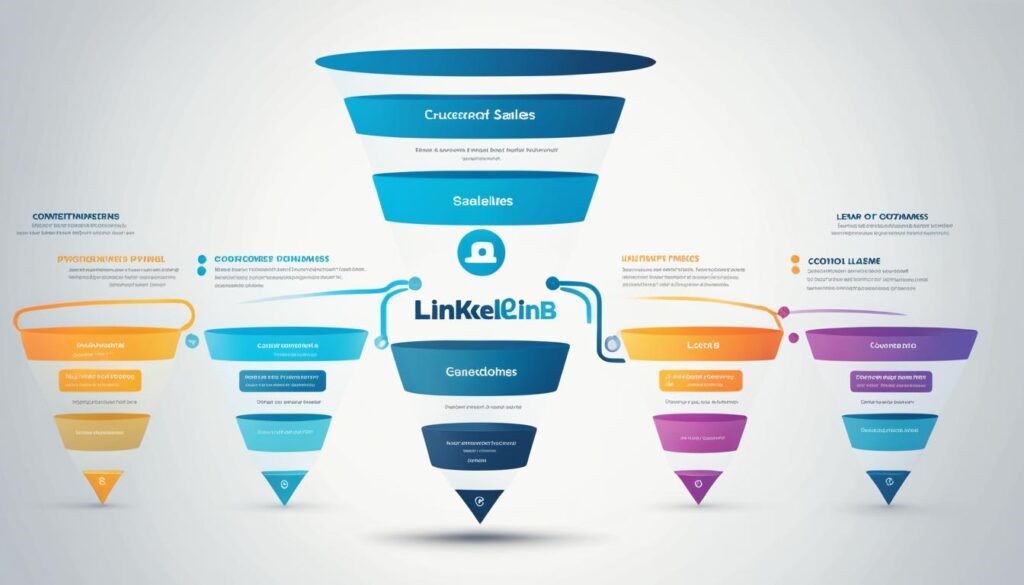I’ve seen the power of LinkedIn for B2B sales funnels. It’s a great way to connect with potential clients and grow your business. I’ll show you how to make a LinkedIn B2B sales funnel. This will help you get quality leads, make your sales process smoother, and increase your profits.
Key Takeaways
- Leveraging LinkedIn to build a B2B sales funnel can significantly enhance lead generation, conversion rates, and customer loyalty.
- A well-structured B2B marketing funnel can reduce customer acquisition costs and support SEO efforts by driving organic website traffic.
- Implementing a B2B marketing funnel on LinkedIn can increase return on investment (ROI) by personalizing marketing campaigns and positioning the brand as an industry authority.
- Measuring performance at each stage of the LinkedIn B2B sales funnel is crucial for identifying bottlenecks and optimizing the overall process.
- Tailoring LinkedIn audience targeting by each stage of the funnel is essential for higher conversion rates and engagement.
Introduction
In the world of B2B sales, having a clear sales funnel is key for growth. LinkedIn helps businesses guide customers from knowing about them to buying. This part will show why LinkedIn is important for sales funnels and explain the B2B sales process.
The Importance of a LinkedIn Sales Funnel for B2B
LinkedIn is a top professional network for B2B businesses to meet their audience. A LinkedIn sales funnel helps companies grow by nurturing leads and showing off their skills. Forrester found that 68% of B2B customers like to learn about products before talking to sellers.
Overview of the B2B Sales Funnel Stages
The B2B sales funnel has several key stages:
- Awareness: Getting potential customers to notice your brand.
- Interest: Getting people interested in what you offer.
- Consideration: Helping leads make up their minds by giving them info.
- Decision: Making strong offers and answering any doubts.
- Action: Closing deals, welcoming new clients, and getting referrals.
Knowing and improving each stage of the B2B sales funnel on LinkedIn can help businesses turn leads into loyal customers. Next, we’ll look at how to use LinkedIn at each step of the sales process.
1. Awareness Stage
The first stage of the LinkedIn B2B sales funnel is about making your brand known. It’s key for getting high-quality leads into your sales pipeline. You need a good plan for your LinkedIn profile, making engaging content, and using ads.
Optimizing Your LinkedIn Profile
Your LinkedIn profile is like your digital storefront. It must make a strong first impression. Make sure it’s current, with a professional photo, a headline that shows your skills, and a summary that lists your skills and experience. Use linkedin profile optimization tips to stand out and be seen as a leader in your field.
Creating Engaging Content
Creating content regularly is key for building brand awareness. Plan a content strategy that includes high-quality blog posts, videos, and social media updates. Use content marketing to make sure your content is interesting, looks good, and gets seen on LinkedIn.
Leveraging LinkedIn Ads for Brand Awareness
LinkedIn ads are a great way to spread the word about your brand and get targeted leads. Try out linkedin ads that show off your skills, promote your content, or highlight your products. Use targeting to make sure your ads reach the right people, and check how your ads are doing to make them better.
By making your LinkedIn profile great, creating engaging content, and using ads, you can build brand awareness. This will help you get qualified leads into your B2B sales funnel.

2. Interest Stage
After catching the eye of potential customers, the next step is the interest stage. Here, we’ll talk about how to find and connect with leads. We’ll also cover how to use LinkedIn groups and communities to share valuable content. Plus, we’ll look at how to keep leads interested with thought-provoking resources.
Identifying and Connecting with Potential Leads
Finding the right leads is key in the interest stage. Use LinkedIn’s advanced search to find people interested in your products or services. Then, personalize your connection requests to show how you can help them.
Utilizing LinkedIn Groups and Communities
LinkedIn groups and communities are great for keeping leads interested. Join groups related to your industry and share your knowledge. This helps you connect with potential customers and shows you’re a leader in your field. You might even start your own group to build a community around your brand.
Sharing Valuable Resources and Insights
Sharing good content is important in the interest stage. Share things like industry reports and how-to guides that solve problems. Use LinkedIn to publish your knowledge and host webinars to keep leads engaged.
| Metric | Description | Importance |
|---|---|---|
| Lead Generation | Track leads from form submissions or newsletter sign-ups to measure the effectiveness of interest stage strategies. | Crucial for evaluating the success of your lead nurturing efforts and identifying potential bottlenecks in the sales funnel. |
| Content Engagement | Measure resource downloads, time spent on web pages, and interaction with your content to gauge lead interest and engagement. | Provides valuable insights into the types of content that resonate most with your target audience, allowing you to refine your content strategy. |
| Social Media Engagement | Analyze likes, comments, shares, and direct messages on your LinkedIn posts and updates to assess social channel engagement. | Helps you understand how your leads are interacting with your brand on social media, enabling you to optimize your content and outreach efforts. |
“Effective lead nurturing is the key to converting interested prospects into loyal customers during the interest stage of the B2B sales funnel.”
3. Consideration Stage
In the consideration stage, you focus on nurturing leads and making your business the top choice. This part talks about how to make InMail messages personal, host engaging webinars and LinkedIn Live sessions, and use case studies and testimonials. These help build trust and credibility with your audience.
Nurturing Leads with Personalized InMail Messages
Personalized InMail messages are key in the consideration stage for nurturing leads. By focusing on their specific needs and problems, you can connect more deeply. Use subject lines that grab their attention, share industry insights, and offer solutions to their issues.
Hosting Webinars and LinkedIn Live Sessions
Hosting LinkedIn webinars and LinkedIn Live sessions is a great way to engage leads. These formats let you show your expertise, answer questions, and share valuable content. Use these platforms to talk about industry trends, share case studies, and give advice that shows you’re a trusted expert.
Providing Case Studies and Testimonials
Showing social proof is key in the consideration stage. Leads want to see proof that your products or services work. Share case studies that show how your clients have succeeded, and use testimonials from happy customers. These examples can show the real benefits of what you offer and help overcome doubts or objections.
By using these strategies, you can nurture your leads, build your credibility, and move them closer to making a decision.

4. Decision Stage
When prospects get to the decision stage, they’re close to buying. This stage is key for offering free trials and demos. It’s also about making strong proposals and answering any doubts they have.
Offering Free Trials and Demos
Letting prospects try your product can build trust. Free trials and demos show them how your solution can help their business. This can make them less unsure about buying.
Crafting Compelling Proposals and Offers
It’s important to make your proposals fit what the prospect needs. Show how your product solves their problems. Be clear about the benefits, cost, and any rules or conditions.
Addressing Objections and Questions
Prospects might still have doubts or questions. Be ready to answer them. Listen to their concerns with empathy. This can make them feel sure about choosing your solution.
Getting through the decision stage needs a careful approach. Offer valuable experiences, make proposals that fit, and answer any doubts. This way, you help prospects make a choice that meets their business needs.
5. Action Stage
The final stage of the LinkedIn B2B sales funnel is the action stage. Here, leads become paying customers. It’s key to close deals smoothly, onboard clients well, keep in touch, and get referrals and reviews.
Closing the Deal and Onboarding Clients
When a lead is ready to buy, make closing the deal easy. Offer a strong proposal, answer any last doubts, and sign the contract fast. Aim for a smooth process that makes the customer happy from the start.
Onboarding clients right is also crucial. A personalized and helpful onboarding sets the stage for a strong relationship. This includes a kickoff call, sharing useful resources, and quickly solving any questions or worries.
Following Up and Ensuring Customer Satisfaction
Keeping in touch and making sure customers are happy keeps them coming back and referring others. After onboarding, check in to get feedback, fix issues, and offer more support. Always be ready to meet their changing needs with your products or services.
Using a system to handle customer reviews helps you improve and show you care about service. Addressing negative feedback and sharing positive reviews builds trust with your audience.
Encouraging Referrals and Reviews
Getting happy clients to refer you and leave good reviews is key for growth. Referrals from friends or colleagues make up 84% of sales and convert 30% better than other leads. Ask your satisfied clients to spread the word or review you on LinkedIn.
Offering rewards, like discounts or special content, can motivate clients to talk about your business. Great service and easy sharing of positive experiences can make word-of-mouth marketing work for you.

| Key Metrics | Benchmark |
|---|---|
| Deal Closing Rate | 55-75% |
| Client Retention Rate | 80-90% |
| Referral Rate | 25-40% |
| Average Customer Satisfaction Score | 4.5/5 or higher |
“Buyers are 2.9 times more likely to remain loyal when vendors offer possibilities to them proactively.”
6. Optimization and Analysis
Creating a top-notch LinkedIn B2B sales funnel is a never-ending task. It needs ongoing work and checking. Make sure your funnel works well by tracking important metrics and KPIs. Analyze each stage and make smart changes over time.
Tracking Key Metrics and KPIs
Good funnel optimization starts with knowing your data. Important metrics for a B2B sales funnel are website traffic, lead generation rates, and conversion rates. These metrics give you insights into your funnel’s health and where to improve.
- Website Traffic: Total visitors to your LinkedIn profile and website.
- Lead Generation Rates: Percentage of website visitors that become leads.
- Conversion Rates: Percentage of leads that become paying customers.
Analyzing Funnel Performance and Identifying Bottlenecks
Checking your funnel performance often helps find problems. Look at the data at each funnel stage. This shows where people are leaving and how to fix it.
If lead generation is low, work on your LinkedIn profile or make your content more engaging. If conversion rates are slow, improve your lead nurturing or offer better deals.
Implementing Continuous Improvements
For a great B2B sales funnel, always be improving. Keep an eye on your KPIs and adjust based on data. This keeps your funnel working better and getting better results.
Ways to make your B2B sales funnel better include:
- A/B testing landing pages and other marketing assets
- Personalizing email outreach and lead nurturing campaigns
- Leveraging marketing automation to streamline lead management
- Aligning sales and marketing efforts to create a seamless customer experience
By focusing on performance analysis and continuous improvement, your LinkedIn B2B sales funnel stays flexible, effective, and meets your audience’s changing needs.

“A well-defined sales funnel can 2x your conversion rate.” – GOCardless
Conclusion
Building a strong LinkedIn B2B sales funnel is key to growing your business. This guide shows you how to make it happen. Start by making your LinkedIn profile stand out. Then, create content that grabs attention and advertise to get noticed.
Next, connect with leads and nurture them with personalized messages. Offer solutions that make sense to them. It’s also important to keep an eye on your funnel and make changes based on what you learn.
Recap of Key Steps for Building a LinkedIn B2B Sales Funnel
Here are the main steps: Make your LinkedIn profile shine. Use content and ads to get your brand known. Find and connect with leads, then talk to them in a way that matters.
Offer solutions that solve their problems. Keep an eye on important numbers and tweak your funnel as needed.
Encouragement to Optimize and Adapt Your Funnel
Remember, things change on LinkedIn and with your audience. Stay flexible and keep making your funnel better. This will help you use LinkedIn to its fullest for your sales and marketing.
Final Thoughts on Driving B2B Sales Through LinkedIn
A well-made and updated LinkedIn B2B sales funnel is a great way to grow in the B2B market. Use LinkedIn’s big network and focus to reach and turn leads into customers. This will help increase your sales and improve your business.
FAQ
What is the importance of building a LinkedIn B2B sales funnel?
What are the key stages of a LinkedIn B2B sales funnel?
How can I optimize my LinkedIn profile to attract potential customers?
What strategies can I use to identify and connect with relevant leads on LinkedIn?
How can I nurture leads in the consideration stage of my LinkedIn B2B sales funnel?
What tactics can I use to guide leads towards a purchasing decision in the decision stage?
How can I optimize the performance of my LinkedIn B2B sales funnel?
Source Links
- How to Build a High-Conversion B2B Marketing Funnel
- How to Build a B2B Sales Process on LinkedIn in 7 Steps
- How to Build Full-Funnel Marketing on LinkedIn (+ Why You Should)
- How to design a B2B sales funnel?
- Guide to leveraging a B2B sales funnel
- B2B Sales Funnel: Understanding Your Business
- Your Guide to the B2B Sales Funnel: What is it and How to Optimize Yours
- How To Build A B2B Sales Funnel: 8 Critical Steps
- Guide to the B2B Sales Funnel – Concentrix
- Marketing Funnel Stages | LinkedIn Ads
- 6 Stages of the B2B Sales Funnel (And How to Build Yours)
- What Is A B2B Sales Funnel – Steps, Tips, And Implementation Guide
- B2B Sales Funnels: Everything You Need to Know to Connect with Prospects and Close Deals
- B2B Sales Funnel: Stages, Models, Best Practices
- 7 Key Stages Unveiled: Navigating the B2B Sales Funnel
- What is an effective way to get a B2B marketing sales funnel?
- How to Build a B2B Sales Funnel That Pulls in Customers
- Tailoring 5 Stages of B2B Sales Funnel To Meet Your Needs
- The 6 Essential B2B Sales Funnel Stages
- 5 Stages of a Successful Sales Funnel
- The Comprehensive Guide to the B2B Sales Funnel
- 6 Stages of B2B Sales Funnel and How to Create an Effective Strategy
- How to Create a B2B Sales Funnel Successfully
- The Complete Guide to Understanding and Optimizing Your B2B Sales Funnel in 2024
- Navigating the B2B Sales Funnel: A Roadmap to Success
- How salespeople should be optimizing B2B sales funnel for maximum conversions?
- Building a Sales Funnel in B2B Manufacturing: A Guide to Track Leads and Boost Conversion